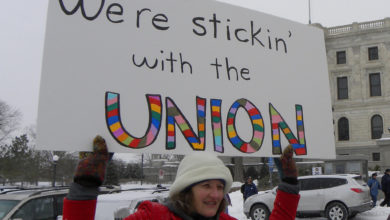This article first appeared in the January 2007 issue of Socialism and Liberation magazine.
Five years ago, on
“We are going to win the war overseas,” Bush told a crowd after signing the bill, “and need to win the war against
|
The bill sets a goal of “100 percent proficiency scores” in math and reading for all children of color and from poor and working-class backgrounds by 2014. It makes schools and states responsible for meeting the standards, and the schools are subject to a variety of penalties for failing to meet certain goals by a certain time frame.
On Oct. 5, Bush and Secretary of Education Margaret Spellings visited an elementary and middle school campus in
Bush and Spellings were there to announce that the achievement gap is closing.
Yet recent results released by the National Assessment of Education Progress, which administers standardized tests to evaluate the country’s progress in education, stated that the “nation’s report card” is not good. The NAEP results show that since the inception of the NCLB law, reading proficiency for eighth-grade Black students dropped from 13 percent to 12 percent. Proficiency dropped from 41 percent to 39 percent for eighth-grade white students.
“Poor and minority students are doing very poorly, and in most states are not making significant gains,” admitted Chester F. Finn of the Thomas B. Fordham Foundation, a group headed by former officials of the Reagan and current Bush administrations. (New York Times, Nov. 20)
“The Bush administration wants to hang a ‘Mission Accomplished’ banner over NCLB, but a fair assessment is that progress thus far in closing achievement gaps is disappointing,” Ross Wiener of the Education Trust told the New York Times.
The use of standardized testing to measure and assess student progress, as well as annual reporting of data on school performance and statewide progress, form the backbone of NCLB. But critics have pointed out that financial support for schools to achieve success lags far behind the needs.
For example, in 2003, the New Hampshire School Administrators Association estimated that the state would receive about $77 in new federal money for each student—while the obligations imposed by the law would cost at least $575 per student.
The NCLB law also penalizes “non-performing” schools. A yearly report card showing up to five “poor” ratings may result in reopening the school as a charter school and a reorganization or shake-up of school staff. These schools are inevitably in the poorest neighborhoods. Nine thousand out of 50,000 schools in poor working-class areas were deemed “failed schools” in 2004-2005—a 50 percent increase from the year before.
Democratic politicians have taken advantage of the failings of NCLB to criticize the Bush administration’s lack of support for education. But amid all the different proposals for reforms, none address the real issues: growing poverty affecting working-class families and the history of racism in the educational system.







